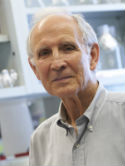Changes in the Structure and Function of ICC Networks in ICC Hyperplasia and Gastrointestinal Stromal Tumors Journal Article
| Authors: | Kwon, J. G.; Hwang, S. J.; Hennig, G. W.; Bayguinov, Y.; McCann, C.; Chen, H.; Rossi, F.; Besmer, P.; Sanders, K. M.; Ward, S. M. |
| Article Title: | Changes in the Structure and Function of ICC Networks in ICC Hyperplasia and Gastrointestinal Stromal Tumors |
| Abstract: | Background & Aims: Gastrointestinal stromal tumors (GISTs) express the receptor tyrosine kinase c-kit. Approximately 90% of GISTs have gain-of-function mutations in the Kit gene, which leads to its constitutive activation and drives malignant behavior of GISTs. Interstitial cells of Cajal (ICC) express c-kit; however, it is unknown whether uncontrolled hyperplasia of ICC is responsible for GISTs. Here, we sought to determine whether gain-of-function mutations in Kit lead to hyperplasia of all classes of ICC, whether ICC hyperplasia begins before birth, and whether functional defects occur in ICC hyperplasia or the development of GISTs. Methods: Heterozygous mutant Kit<sup>V558Δ</sup>/+ mice that develop symptoms of human familial GISTs and prematurely die from pathology of the gastrointestinal tract were utilized and compared with wild-type controls. C-kit-immunohistochemistry and intracellular electrical recording of spontaneous and nerve-evoked activity were applied to examine the density and functionality of ICC in these mutants. Results: There was considerable hyperplasia in all classes of ICC throughout the GI tract of Kit<sup>V558Δ</sup>/+ mice, except for ICC in the deep muscular plexus of the intestine. Spontaneous electrical activity and postjunctional neural responses in hyperplastic ICC tissues appeared normal but were up-regulated in the cecum, where GISTs were commonly found. Conclusions: Kit gain-of-function leads to hyperplasia of most classes of ICC throughout the GI tract. ICC retain normal pacemaker function and enteric neural responses well after development of hyperplasia. © 2009 AGA Institute. |
| Keywords: | immunohistochemistry; controlled study; gene mutation; histopathology; nonhuman; mouse; animals; mice; animal tissue; cell function; gastrointestinal stromal tumor; stem cell factor; cell structure; interstitial cell of cajal; gastrointestinal stromal tumors; proto-oncogene proteins c-kit; animal experiment; mice, mutant strains; wild type; heterozygosity; hyperplasia; upregulation; fetus; c57bl 6 mouse; disease models, animal; gastrointestinal tract; enteric nervous system; colon; birth; cecum; cell hyperplasia; cell mutant; electric activity; electric potential; intestine muscle; nerve potential; electrophysiological processes; gastric fundus; ileum; jejunum; muscle, smooth; pyloric antrum |
| Journal Title: | Gastroenterology |
| Volume: | 136 |
| Issue: | 2 |
| ISSN: | 0016-5085 |
| Publisher: | Elsevier Inc. |
| Date Published: | 2009-02-01 |
| Start Page: | 630 |
| End Page: | 639 |
| Language: | English |
| DOI: | 10.1053/j.gastro.2008.10.031 |
| PUBMED: | 19032955 |
| PROVIDER: | scopus |
| PMCID: | PMC4782934 |
| DOI/URL: | |
| Notes: | --- - "Cited By (since 1996): 2" - "Export Date: 30 November 2010" - "CODEN: GASTA" - "Source: Scopus" |
Altmetric
Citation Impact
BMJ Impact Analytics
Related MSK Work





